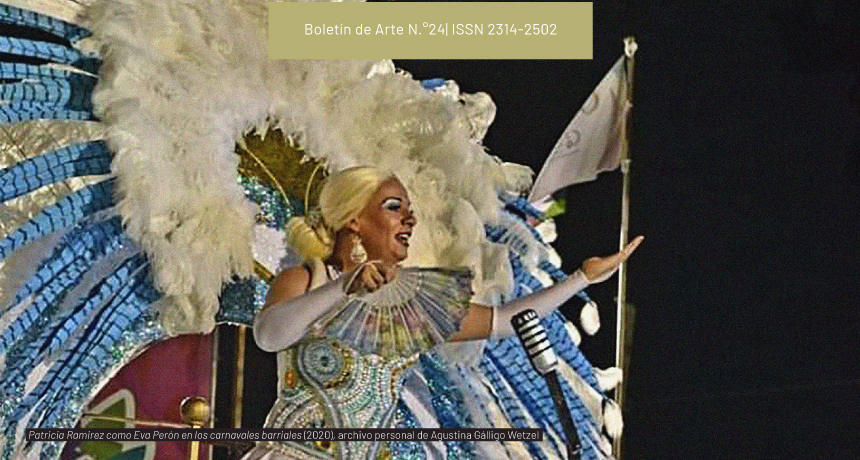Seamstress, Sex Worker and Comparsera
Patricia Ramirez’s Trans Evita
DOI:
https://doi.org/10.24215/23142502e045Keywords:
Evita, dress, carnival, transAbstract
This article seeks to analyze the work of transgender artist Patricia Ramirez (City of Corrientes, 1981) in the framework of the 2020’s neighborhood carnivals where she performed as Eva Perón. The dress as an object that assembles materialities, affections and political history in the context of carnivals will allow us to complete the analysis of the work and its effects as a language where pragmatics of collective resistance, forms of life and common languages are intertwined.Downloads
References
Aira, C. (1991). Copi. Beatriz Viterbo.
Aslan, N. (2003). Zapatito [Escultura en hierro, plumas y tela]. http://untref.edu.ar/muntref/es/muestras/evita-de-coleccion/
Barreda, F. (1997). Proyecto Hábitat [Fotografía y maquetas de acrílico]. http://untref.edu.ar/muntref/es/muestras/evita-de-coleccion/
Borrelli Azara, G. (Comp.). (2021). Si Evita viviera. Antología de poesía lesboperonista. Puntos suspensivos ediciones.
Campuzano, G. (2008). Museo Travesti del Perú. Institute of Development Studies.
Copi [1970] (2000). Eva Perón (Trad. J. Monteleone). Adriana Hidalgo.
DaMatta, R., Vasconcellos, J. G. M. y Pandolfi, R. S. (2016). Tanto Igualdade quanto Hierarquia?. Revista Interdisciplinar de Gestão Social, 4(3), 137-148. https://periodicos.ufba.br/index.php/rigs/article/view/11729
Costantino, N. (2013). Rapsodia Inconclusa [Serie]. 55° Bienal de Venecia.
Foster, D. W. (2004). La representación del cuerpo queer en el teatro latinoamericano. Latin American Theatre Review, 23-38.
Gago, V. (2014). La razon neoliberal: economías barrocas y pragmática popular. Tinta Limón.
Gluzman, G.; Palmeiro, C.; Rojas, N.; Rosemberg, J. (2022). Las olas del deseo. Sobre Feminismos, diversidades y cultura visual. Ministerio de Cultura Argentina.
Hakim, P. (2003). Sin Título [Técnica mixta, impresión sobre plástico troquel]. http://untref.edu.ar/muntref/es/muestras/evita-de-coleccion/
Harrington, E. (2003). Todos somos Evita [Fotografía, retoque digital]. http://untref.edu.ar/muntref/es/muestras/evita-de-coleccion/
Jamandreu, P. (2019). Evita fuera del Balcón. Caballo Negro.
Lepecki, A. (6 de julio de 2016). Coreopolicía y corepolítica o la tarea del bailarín. Nexos. http://cultura.nexos.com.mx/?p=10775
Ley 27636 de 2021. Ley de Promoción del acceso al Empleo formal para Personas Travestis, Transexuales y Transgénero «Diana Sacayán-Lohana Berkins». 8 de julio de 2021. D. O. No. 34697.
López, M. (2019). Ficciones disidentes en la tierra de la misoginia. Pesopluma.
Martínez, T. E. (1995). Santa Evita. Roman Suhrkamp.
Melo, A. (2020). Paco y Eva: las vidas paralelas de Evita Perón y Paquito Jamandreu: erotismo, política y diversidades sexuales en la literatura autobiográfica peronista. Aurelia Rivera.
Messing, A. (2002). El Adiós [óleo sobre tela]. http://untref.edu.ar/muntref/es/muestras/evita-de-coleccion/
Molina, D. (17 de abril de 2017). Una Evita trans: así es la «Eva Perón» de Copi que se verá en el Cervantes. Infobae. https://www.infobae.com/cultura/2017/04/17/una-evita-trans-asi-es-la-eva-peron-de-copi-que-se-vera-en-el-cervantes/
Mujica Pinilla, R. (1992). Ángeles apócrifos en la América Virreinal. Fondo de Cultura Económica.
Navarro, M. (1981). Evita. Buenos Aires. Corregidor
Olmi, M. (2011). Domingo, ñoquis para todos, de la serie «El humor alarga la mirada de la inteligencia» [Acrílico y óleo sobre lienzo]. http://untref.edu.ar/muntref/es/muestras/evita-de-coleccion/
Pecci Carou, F. (2020). Evita en Christian Dior [Acrílico sobre tela]. https://es.artealdia.com/ Noticias/realidad-ficcion-del-feminismo-el-museo-evita-reabre-con-una-muestra-de-fatima-pecci-carou
Perlongher, N. (2013). Prosa Plebeya. Excursiones.
Sarlo, B. (2003). La pasión y la excepción. Siglo XXI Editores Argentina.
Downloads
Published
How to Cite
Issue
Section
License
Copyright (c) 2022 Agustina Gálligo Wetzel

This work is licensed under a Creative Commons Attribution-NonCommercial-ShareAlike 4.0 International License.
According to these terms, the material can be copied and redistributed by any means or in any format as long as a) the author and original source of the publication are quoted (magazine and URL of the work), access to the license is provided and whether changes have been made is mentioned; and b) the material is not used for commercial purposes.
The cession of non-exclusive rights means that after the publication (post print) in Boletín de Arte the authors can publish their work in any language, means and format; in such cases it must be mentioned that the material was originally published in this magazine.
Such cession also means the authorization of the authors for the work to be collected by SEDICI, the institutional archive of the National University of La Plata, and to be spread in the databases that the editorial team considers appropriate to increase the visibility of the publication and its authors.
Moreover, the magazine encourages the authors to deposit their productions in other institutional and thematic archives under the principle that offering the society the scientific and academic production without any restrictions contributes to a greater exchange of the global knowledge.
































